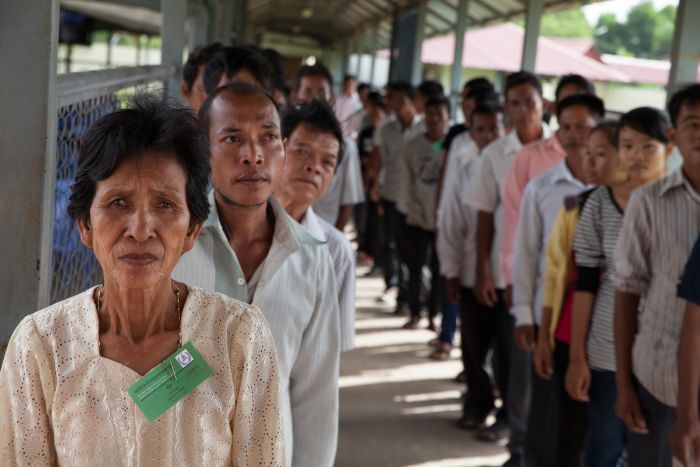Documents 1–8: Summaries and Links
Document 1
Date: June 9, 1993
Protocol of Agreement between the Government of Rwanda and the Rwandan Patriotic Front on the Repatriation of Rwandan Refugees and the Resettlement of Displaced Persons
Initiated in a blaze of optimism, the refugee protocol recognizes the “indisputable right” of Rwandan refugees to return to their country of origin “without any precondition whatsoever.” It also establishes a timetable for resettlement efforts linked to the establishment of a new, broad-based transitional government, or BBTG. Since the transitional government is never established, the protocol is never implemented.

Burundian refugees in southern Rwanda, October 1993. —B. Press/UNHCR
Document 2
Date: October 14, 1993
To: American Embassy Kigali [Rwanda]
From: [US] Secretary of State [Washington, DC]
Subject: [President] Habyarimana Working Visit to Washington and Meeting with [Assistant Secretary of State George] Moose
Cable #: State 313592
In early October 1993, the president of Rwanda, Juvénal Habyarimana, reviews the status of the repatriation program with US diplomats during an official visit to Washington. He says the Rwandan government is issuing passports to Rwandan exiles and urges the United Nations to step up its assistance and resettlement efforts.
Document 3
Date: October 25, 1993
To: [Head of Military Division at UN Department of Peacekeeping Operations Maurice] Baril for [Undersecretary for Peacekeeping Operations Kofi] Annan, United Nations, New York
From: [Roméo] Dallaire, Force Commander, UNAMIR, Kigali, Rwanda
Subject: UNAMIR Situation Report 1
Just three days after taking up his new post in Kigali, UNAMIR commander Roméo Dallaire cites the influx of some 200,000 refugees from Burundi as an additional headache in his first situation report to New York. He mentions signs of “ethnic frictions in the refugee camps” and expresses concern about a lack of resources to deal with the overall refugee crisis, which could “destabilize peace implementation plans.”
Document 4
Date: November 4, 1993
To: [US] Secretary of State [Washington, DC]
From: American Embassy Kigali [Rwanda]
Subject: Burundi Refugees: Numbers Up, Coordination Coming Together
Cable #: Kigali 03970
In a dispatch from Kigali, US Ambassador Robert Flaten reports that the arrival of predominantly Hutu refugees from Burundi (now estimated at 375,000) could create political problems inside Rwanda. He states that embassy officials are “gaining an understanding of the intimate link between what happens in Burundi and the security situation in Rwanda.”
Document 5
Date: November 16, 1993
To: [US] Secretary of State [Washington, DC]
From: American Embassy Kigali [Rwanda]
Subject: Burundi Crisis: Potential Regional Tensions
Cable #: Kigali 04084
Ambassador Flaten reports on rumors of “military recruitment activity” by Hutu nationalists from Burundi (known as PALIPEHUTU) following the attempted coup in Burundi. He acknowledges the United States lacks concrete information about the situation in the camps.
Document 6
Date: November 23, 1993
To: [Undersecretary for Peacekeeping Operations Kofi] Annan, United Nations, New York
From: [Force Commander of UNAMIR Roméo] Dallaire, UNAMIR, Kigali, Rwanda
Subject: Weekly Situation Report No. 6
Cable #: UNAMIR 002
Describing the situation inside the Rwandan government forces (RGF) sector, Dallaire cites further reports of political factions “arming and training young men in and around the Burundi refugee camps.” He adds that UNAMIR is attempting to get a “reasonable recce [reconnaissance] party” into the area “to show the UN flag” but needs more military monitors. In his 2003 book, Shake Hands with the Devil, Dallaire recalled that his superiors had rejected a request for an additional 48 unarmed observers to help monitor the situation in the refugee camps.
Document 7
Date: December 1, 1993
To: [US] Secretary of State [Washington, DC]
From: American Embassy Kigali [Rwanda]
Subject: Potential Regional Tensions
Cable #: Kigali 04247
According to the US embassy in Kigali, the UN High Commissioner for Refugees has become deeply concerned about security in the Hutu refugee camps in southern Rwanda. Meanwhile, an American aid worker reports seeing a group of young men in military uniforms at a refugee camp, including one with “a rocket launcher on his shoulders.”
Document 8
Date: January 19, 1994
To: [US] Secretary of State [Washington, DC]
From: American Embassy Kigali [Rwanda]
Subject: Refugee Update
Cable #: Kigali 00252
The US embassy in Kampala provides an update on the Rwandan refugee situation. An international “plan of action” for Rwandan refugees is “on hold” pending the formation of a transitional government, which has been blocked by internal political disputes.

